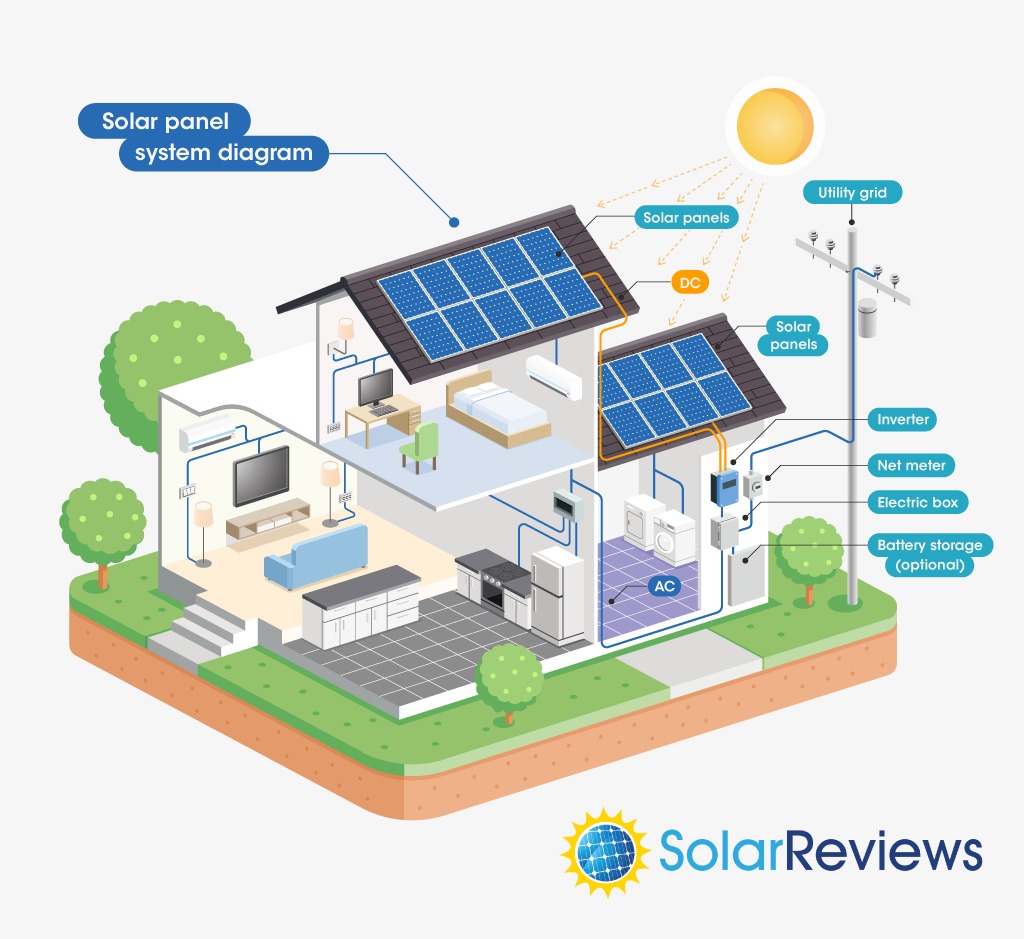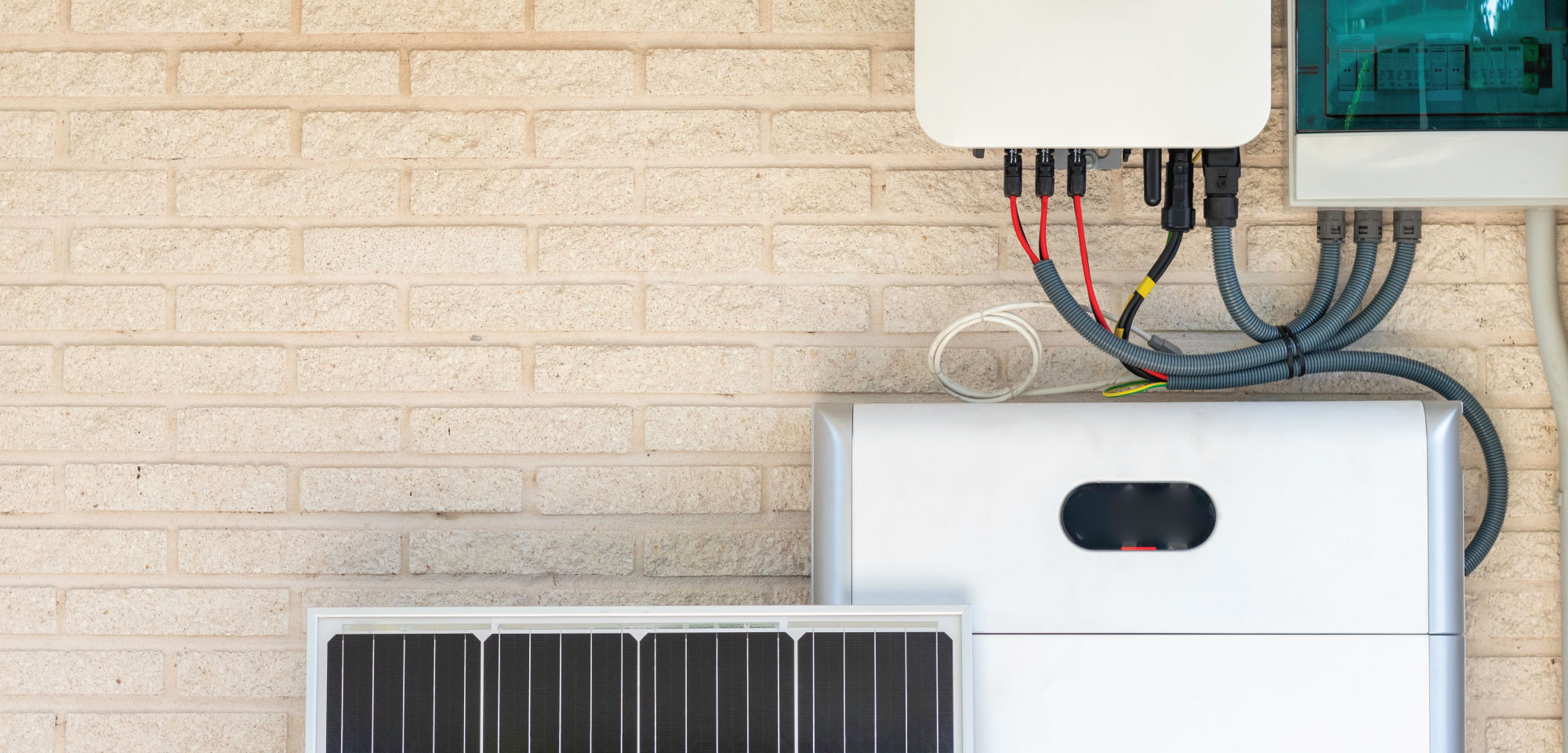Updated 3 months ago
Solar power system equipment: needs, costs, pros, and cons
Written by Catherine Lane Catherine LaneCatherine has been researching and reporting on the solar industry for five years and is the Written Content Manager at SolarReviews. She leads a dyna...Learn more

Why you can trust SolarReviews
SolarReviews is the leading American website for solar panel reviews and solar panel installation companies. Our industry experts have a combined three decades of solar experience and maintain editorial independence for their reviews. No company can pay to alter the reviews or review scores shown on our site. Learn more about SolarReviews and how we make money.
Key takeaways
There are three main types of residential solar panel installations: grid-tied, hybrid, and off-grid.
Grid-tied systems are the most common and the cheapest because they use the least amount of equipment: solar panels, wiring, racking, grid-tied inverters, and a net meter.
Hybrid solar systems use the same equipment as grid-tied systems but also include a charge controller, energy storage system, and a hybrid inverter capable of connecting the solar system and battery to each other and the grid.
Off-grid solar systems do not have any connection to the grid and require large energy storage systems to ensure there is enough power to run the home.
What is a solar panel system?
A roof-mounted solar panels system absorbs and converts the energy-packed photons of natural sunlight into a usable energy form. Solar panel systems are often referred to as PV, or photovoltaic, solar power systems.
The home installation of a high-quality solar power system can reduce or eliminate dependence on the utility power grid that supplies electricity to light, heat, cool, and operate your home.
Residential solar power system installations result in a clean, renewable energy source that requires minimal maintenance with savings that could pay back the initial investment in just a few years!
Most professionally installed solar panel systems cost between $18,000 and $20,000 before factoring in any rebates or incentives. Once your solar system is paid off, you will have decades of free energy.
There are three main types of home solar systems; the right one for you depends on your specific needs.
Grid-tied
Hybrid
Off-grid
Grid-tied solar system
A grid-tied system is the most common type of solar system. It has no solar battery for backup power and utilizes net metering to maximize savings. Solar panels are mounted on your roof then wired together, and the power generated flows into an inverter where direct current (DC) electricity is converted into alternating current (AC) electricity. This electricity is either used by your home or is exported to the utility grid.
What are the main components of a solar panel installation?

Understanding the components of a solar power system is the first step to finding the right system for you. The components of a grid-tied home solar power system include:
Solar panels
Solar inverter
Solar racking
Net meter
Solar performance monitoring
Hybrid and off-grid solar system types will require additional equipment. Aside from the equipment listed above, they will also use:
Solar battery storage
Charge controller
Solar panels
The solar panels themselves are the key elements of a solar power system - they’re what produces the electricity! All solar systems, no matter the type, will have solar panels.
Solar panels are made up of solar cells made of silicon that are wired together to make solar modules. Some of the best solar panel brands include Qcells, Silfab Solar, and JA Solar.
Most solar panels installed today are monocrystalline solar panels, but there are other solar panel types available.
Solar inverter
Solar inverters are the mechanisms that convert the direct current (DC) produced by the solar panels into the alternating current (AC) that homes require.
Inverters come in three types:
String inverters: They are the least expensive but can be inefficient. This is because there is potential production loss if there is shading on the roof.
Microinverters: These inverters are more expensive and are attached to each solar panel, allowing for smooth operations even when some panels are shaded.
Power optimizers: Installed in each panel, they optimize the DC output of each PV module, which then goes on to a string inverter for conversion to AC power. They are less expensive than microinverters but slightly more expensive than string inverters.
Solar racking
Solar panels are not attached to the roof directly. Panels are mounted on racking systems, which are attached to the roof and angled for the optimal degree of sun exposure.
Net meter
A net meter is a key component of solar systems that are connected to the grid if your utility offers net metering.
If your utility company offers net metering and you have grid-connected solar, with or without a battery, any solar electricity that you produce that you don’t use (or store in your battery) is sent to the grid. With net metering, your utility will pay you for that electricity you send, which lowers your electric bill.
A special electric meter, called a' net meter, ' is required to keep track of how much electricity your solar panels produce versus how much electricity you use from the utility.
Since they aren’t connected to the utility, off-grid solar systems do not need a net meter.
Solar performance monitoring
To verify the performance of your PV system, a monitoring system will show you how much electricity is being generated per hour, per day, or per year. The system can identify potential performance changes, as well.
Solar battery storage
Solar batteries can be added to your solar system to store solar energy for later or if you want to use it overnight. Storage batteries also allow a PV system to operate when the electric grid is not available. If you want your solar panels to operate during a power outage, you need to pair them with a solar battery.
Hybrid solar systems and off-grid systems both use solar energy storage. However, off-grid systems require more batteries because they don’t have the grid to fall back on like hybrid systems do.
Charge controller
Charge controllers are only used for solar power systems that have battery storage. Grid-tie systems without batteries do not require a charge controller.
Charge controllers are installed between the solar panels and the battery to prevent the batteries from being overcharged and to ensure that the battery is charged by the right voltage level. If overcharged, batteries can catch on fire, so a charge controller is essential in making sure your battery system is safe and long-lasting.
Can you install a solar power system yourself?
You can install solar panels yourself if you’re looking to save money on installation costs. Many people who decide to go the DIY route use solar panel kits that cost anywhere from $7,000 to $15,000 to cover all of their energy usage.
While DIY solar installations may save you a little bit of money upfront, they will require a substantial amount of time to install, you need to design and wire the solar panels properly, and the job can be dangerous. Not only that, but you’ll have to manage permitting and inspections on your own, which can be quite difficult.
Some utilities won’t even allow you to connect DIY solar installations to the grid, and you could void out some of your equipment warranties, as well.
In short, yes you can install a solar power system yourself, but we don’t recommend it.
Learn more: DIY solar panel guide
Who should I use to install my solar system for home?
Proper installation can be as critical to future performance and return on your investment as the quality of the equipment. Extensive training and a complete understanding of each element are essential.
Many of the best manufacturers have partnered with qualified solar installers in each geographic area. These companies provide onsite training and verification of professional installers before certification.
To find out if a solar panel system is a worthwhile and attainable investment for you, use the solar calculator below to gather the information you need to make a decision.
Catherine has been researching and reporting on the solar industry for five years and is the Written Content Manager at SolarReviews. She leads a dynamic team in producing informative and engaging content on residential solar to help homeowners make informed decisions about investing in solar panels. Catherine’s expertise has garnered attention from leading industry publications, with her work being featured in Solar Today Magazine and Solar ...
Learn more about Catherine Lane